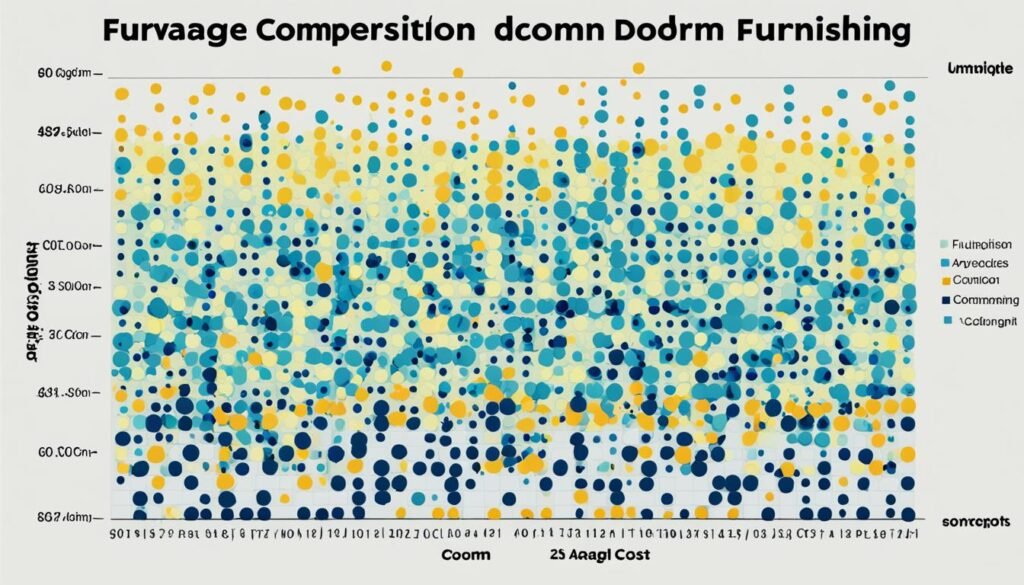Welcome to the exciting world of college life, where you get to furnish your very own dorm room or apartment! But let’s face it – being a student often means working with a tight budget. The good news is that with a little creativity and savvy shopping, you can transform your living space into a cozy and stylish haven without breaking the bank.
In this article, we’ll share valuable tips and tricks on how to furnish your dorm room or apartment on a student budget. From space planning and setting a budget to finding secondhand treasures and affordable decorating ideas, we’ve got you covered. So, let’s dive in and discover how you can decorate your space while saving money.
One of the key strategies to furnishing your dorm room or apartment on a budget is to consider secondhand finds. Not only can you find unique pieces with character, but you’ll also save money in the process. We’ll explore the best places to find secondhand furniture and provide tips on how to repurpose or refurbish these items to give them a fresh look.
Whether you’re a student at the Continents States University (CSYou) or any other educational institution, this article will equip you with the knowledge and inspiration to transform your living space into a reflection of your personal style, even on a student budget.
So, get ready to unleash your creativity and turn your dorm room or apartment into a comfortable and stylish retreat. Let’s begin the journey of furnishing your space!
Planning Your Space
Before you start furnishing your dorm room or apartment, it’s essential to plan your space effectively. By taking the time to consider the size and shape of the area, you can maximize every inch of your small space.
One strategy for space planning is to look for multifunctional furniture pieces. These versatile items serve multiple purposes, saving you both space and money. Consider options like storage ottomans that double as seating or futons that can be used as both a sofa and a bed.
Another way to optimize your small space is by using space-saving storage solutions. Invest in under-bed storage containers to stow away items that you don’t use every day, and utilize hanging organizers to keep your belongings tidy while maximizing vertical space. These clever storage solutions will help you keep your space organized and clutter-free.
To ensure that everything fits smoothly into your space, don’t forget to take measurements. Measure the dimensions of your room and the furniture you plan to bring in. This will help you avoid any surprises and ensure that each piece fits perfectly in its designated spot.

By planning your space carefully, considering multifunctional furniture, using space-saving storage solutions, and taking accurate measurements, you can make the most of your small living area. Your dorm room or apartment will feel spacious, organized, and comfortable, creating a welcoming environment that makes the most of every square foot.
Setting a Budget
Before you start furnishing your dorm room or apartment, it’s important to set a budget. Determining how much money you can allocate to furnishings will help you make informed decisions and prioritize your purchases.
Researching affordable options is key to staying within your budget. Consider exploring secondhand stores, such as thrift shops or consignment shops, where you can find quality furniture at a fraction of the cost. Online marketplaces like Craigslist or Facebook Marketplace can also be great places to find affordable used furniture.
Additionally, keep an eye out for sales or discounts on furniture and home goods. Many retailers offer seasonal discounts or clearance sales where you can score great deals on items you need for your living space.
If you’re feeling creative, consider taking on some DIY projects to save money on decor items. You can revamp old furniture with a fresh coat of paint or create your own artwork to add a personal touch to your space.
Remember, prioritizing essential items is essential when setting a budget. Allocate a larger portion of your budget to these necessities, such as a mattress or a desk, and look for more affordable options for non-essential items.

Setting a Budget Checklist:
- Decide on your overall budget for furnishing your living space.
- Research affordable options like secondhand stores and online marketplaces.
- Keep an eye out for sales and discounts on furniture and home goods.
- Consider DIY projects to save money on decor items.
- Allocate a larger portion of your budget to essential items.
Finding Secondhand Finds
When it comes to furnishing your dorm room or apartment on a student budget, secondhand furniture can be a lifesaver. Not only can it save you money, but it also adds character and uniqueness to your space. To find the perfect secondhand finds, there are a few places you can explore.
Thrift Stores and Consignment Shops
Thrift stores and consignment shops are treasure troves for affordable and one-of-a-kind furniture pieces. These stores often have a wide selection of pre-loved items that are still in great condition. Take the time to browse through their inventory and you might stumble upon a hidden gem.
- Inspect the furniture thoroughly before making a purchase to ensure it’s in good condition.
- If you find any issues, negotiate the price with the store owner.
- Consider repurposing or refurbishing secondhand items to give them a fresh look that matches your style.
Online Classifieds and Marketplace Platforms
Another great option for finding secondhand furniture is to check online classifieds and marketplace platforms. Websites like Craigslist, Facebook Marketplace, and eBay have a wide range of furniture listings from people looking to sell their used items. This gives you the opportunity to find affordable furniture options from the comfort of your own home.
- Always exercise caution when buying from online platforms and meet up in a safe public place.
- Communicate with the seller to get more details about the condition and history of the items.
Remember, secondhand furniture doesn’t mean compromising on quality or style. With a bit of patience and creativity, you can find unique pieces that fit your budget and reflect your personal taste. So, don’t shy away from exploring thrift stores, consignment shops, and online classifieds to discover amazing secondhand finds for your dorm room or apartment.

Affordable Decorating Ideas
When furnishing your dorm room or apartment on a student budget, finding budget-friendly decor options is essential. With a little creativity and DIY projects, you can transform your space into a stylish and cozy environment without breaking the bank.
One affordable way to add character to your walls is by creating a gallery wall. Purchase inexpensive frames and fill them with printed photos or artwork that reflects your personal style. Arrange them in a visually appealing layout, and you’ll have an eye-catching focal point in your room.

Another cost-effective option for adding visual interest to your walls is by using removable wallpaper or decals. They are easy to apply and remove, making it ideal for dorm rooms where you may not be allowed to paint or make permanent changes to the walls. Choose patterns or designs that complement your overall aesthetic.
Don’t underestimate the power of accessories when it comes to decorating on a budget. Decorative pillows, blankets, and curtains can instantly add color and coziness to your space. Look for affordable options that align with your preferred color scheme and style.
If you’re feeling crafty, DIY projects can be a fun and budget-friendly way to personalize your space. Consider painting furniture in a fresh color or distressing it for a vintage look. You can also create your own artwork using canvas, paints, and stencils. These DIY touches will add a unique touch to your decor while keeping costs low.
Incorporating these affordable decorating ideas will help you create a space that reflects your style and personality without exceeding your budget. Get creative, unleash your inner DIY enthusiast, and enjoy furnishing your dorm room or apartment in a way that is both cost-effective and visually appealing.
Maximizing Storage
In small living spaces like dorm rooms or apartments, maximizing storage is crucial. Without adequate storage solutions, your space can quickly become cluttered and chaotic, making it difficult to relax and unwind. By implementing smart organizing tips, you can create an organized and functional living space that meets your storage needs.
Invest in Storage Solutions
To keep your belongings organized, invest in storage bins, baskets, and shelving units. These versatile storage solutions come in various sizes and designs to cater to your specific needs. Use storage bins and baskets to group similar items together and keep them neatly tucked away. Shelving units provide additional space for displaying decor pieces or storing books, ensuring your space remains both functional and aesthetically pleasing.
Utilize Vertical Space
In small spaces, every inch counts. Make the most of your vertical space by installing wall-mounted shelves or hanging organizers. These practical solutions free up valuable floor space and allow you to store frequently used items within easy reach. Take advantage of empty wall space in your dorm room or apartment to add extra storage capacity without sacrificing style.
Furniture with Built-in Storage
When selecting furniture pieces, consider options with built-in storage capabilities. Ottomans with hidden compartments or beds with storage drawers are ideal for maximizing space while keeping your belongings out of sight. These dual-purpose pieces not only provide extra storage space but also contribute to the overall functionality and organization of your living area.
Regular Decluttering
To maintain an organized living space, it’s essential to regularly declutter and purge items you no longer need. Set aside time each month to go through your belongings and assess what you use and what you can do without. Donate or sell any items that no longer serve a purpose in your life. By keeping your space clutter-free, you’ll create a peaceful and inviting environment.
Conclusion
Furnishing your dorm room or apartment on a student budget may seem challenging, but with some planning and creativity, it can be done. By considering affordable options and incorporating budget-friendly decor ideas, you can create a cozy and stylish living space without breaking the bank.
One of the key strategies is to prioritize essential items and allocate a larger portion of your budget to those. This ensures that you have the necessary furniture and functional pieces before focusing on decorative items. Additionally, exploring secondhand finds can be a great way to save money while still finding unique and quality pieces for your space. Visit local thrift stores, consignment shops, and online classifieds to discover hidden gems.
Another effective approach is to embrace DIY projects. Get creative and personalize your space by painting furniture, creating your own artwork, or repurposing secondhand items. Not only does this save money, but it also adds a personal touch and sense of accomplishment to your decor.
Remember, furnishing your dorm room or apartment on a student budget doesn’t mean sacrificing style and comfort. With these tips in mind, you can transform your living space into a welcoming home that reflects your personality while staying within your allocated budget. Start planning, get inspired, and enjoy the process of making your space truly yours.


